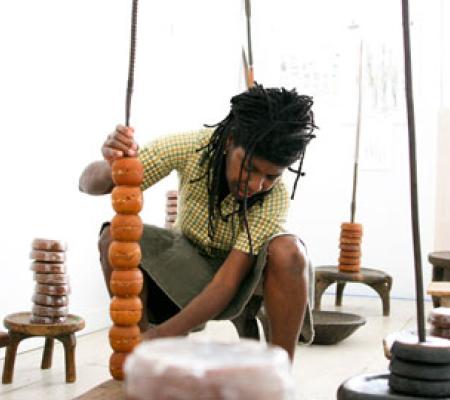The Neon Queen Collective’s members, a trio of Austin-based curators and University of Texas at Austin doctoral students — Jessi DiTillio, Kaila Schedeen, and Phillip Townsend — have been quietly executing progressive, thought-provoking exhibitions and projects in Austin and at The University of Texas at Austin for over a year. However, as a collective, they are preparing their biggest, most visible venture yet—a major exhibition that would bring internationally-celebrated Afro-Cuban artist, Maria Magdalena Campos-Pons to Austin.
As a collective, the Neon Queens are planning visual art exhibitions, workshops, lectures, performances and discussions that seek to broaden the diversity of Austin’s contemporary art community. “We started meeting regularly and planning on how to bring our shared vision of what we’d like to see in the contemporary art world to life,” said Schedeen. That vision invested itself in social activism and meant foregrounding voices of feminist-oriented artists of color and their allies.
In 2016-2017 alone, DiTillio curated the critically well-received Nobody’s Darling at UT’s Christian-Green Gallery of work from Austin-based artist Deborah Roberts and Townsend curated Light and Life: St. Louis Cemetery through the 2016 Lens of John Pinderhughes at Gordon White Building’s IDEA Lab. Schedeen’s How We Become Human: Selections for Native American Heritage Month, a selection of works from across the UT Austin library collections that aims to highlight the continuity of cultural production by indigenous makers in the past thirty years, will be on view in the UT Fine Arts Library until the end of December. Each project is illustrative of the curatorial mission of the collective and building towards a major exhibition in Austin.
“I first met Maria Magdalena Campos-Pons two years ago when I was attending The University of South Florida in Tampa,” wrote Townsend in the acknowledgements to his UT master’s thesis. “I had never seen her work; however, when I spoke with her, she was accessible, generous, and interested in my scholarship. I knew at that moment I wanted to study her work in graduate school.”
An entrée to Campos-Pons and her work, Townsend’s thesis, “(Re)Framing Resistance and (Re)Forging Solidarity: Negotiating the Politics of Space, Race, and Gender in Maria Magdalena Campos-Pons’ Habla La Madre” examines Campos-Pons’ 2014 Guggenheim performance as a manifestation of the artist’s “hybridized ‘exilic,’ ‘female,’ ‘African,’ and ‘Cuban’ identities. As the Neon Queen Collective has framed her work, Campos-Pons’ career is dedicated to picturing and exploring the experience of transnational immigration and cultural hybridization, both personally and universally. This focus makes her work especially important in our current political climate, in which immigrants are struggling for human recognition. Bringing this exhibition to UT’s campus benefits students, faculty, and staff by providing a platform for open, whole-hearted discussion about the immigrant experience.
The Neon Queens hope to achieve a two-part exhibition and catalogue through a crowd-funding campaign. The first part will open at the Warfield Center’s Christian-Green Gallery on January 16, 2018 and involves a large-scale sculptural installation, as well as video, drawing, and photography. The second, to be held at the Visual Art Center in the Fall of 2018, will be the first retrospective of Campos-Pons video work, featuring a selection of pieces from the last 30 years of her career. As of Monday, November 20, 2017, the Neon Queens are 49% of the way to their goal of raising $15,000. The fundraising campaign ends on November 29, 2017. To read more about the Neon Queen Collective, Maria Magdalena Campos-Pons and to donate to their campaign, please visit their Hornraiser page.


